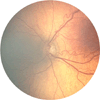Agreement among pediatric ophthalmologists in diagnosing plus and pre-plus disease in retinopathy of prematurity
- PMID: 18329925
- PMCID: PMC2605610
- DOI: 10.1016/j.jaapos.2007.11.022
Agreement among pediatric ophthalmologists in diagnosing plus and pre-plus disease in retinopathy of prematurity
Abstract
Purpose: Plus disease has become the major criterion for laser treatment in infants with retinopathy of prematurity (ROP), but its assessment is subjective. Our purpose was to compare quadrant-level and eye-level assessment of plus disease and pre-plus disease among 3 experienced ROP examiners and to report their rate of agreement.
Methods: One hundred eighty-one high-quality RetCam images from premature infants were graded by 3 of the authors. Dilation and tortuosity were judged separately using a scale of normal or sufficiently abnormal to meet criteria for pre-plus or plus disease.
Results: There was disagreement on the presence of plus disease for 18 images (10%), on tortuosity sufficient for plus disease (plus tortuosity) for 26 images (14%), and on dilation sufficient for plus disease (plus dilation) for 26 images (14%). Of 67 images judged to have pre-plus disease or worse, there was disagreement on the presence of plus disease for 18 images (27%), on plus tortuosity for 25 images (37%), and on plus dilation for 21 images (31%). For distinguishing plus or pre-plus disease from normal, there was disagreement on pre-plus tortuosity for 38 of 181 images (21%) and on pre-plus dilation for 58 of 181 images (32%).
Conclusions: Three experienced ROP examiners disagreed frequently on the diagnosis of plus or pre-plus disease when evaluating cropped clinical photographs of infants, many of which had borderline plus disease. Further study is required to determine the implications of these observations on clinical decision making.
Figures

References
-
- The Committee for the Classification of Retinopathy of Prematurity. An international classification of retinopathy of prematurity. Arch Ophthalmol. 1984;102:1130–1134. - PubMed
-
- An International Committee for the Classification of Retinopathy of Prematurity. The International Classification of Retinopathy of Prematurity Revisited. Arch Ophthalmol. 2005;123:991–999. - PubMed
-
- Early Treatment for Retinopathy of Prematurity Cooperative Group. Revised indications for the treatment of retinopathy of prematurity: Results of the early treatment of retinopathy of prematurity randomized trial. Arch Ophthalmol. 2003;121:1684–1694. - PubMed
-
- Cryotherapy for Retinopathy of Prematurity Cooperative Group. Multicenter trial of cryotherapy for retinopathy of prematurity: Preliminary results. Arch Ophthalmol. 1988;106:471–479. - PubMed
-
- Capone A, Jr, Ells AL, Fielder AR, Flynn JT, Gole GA, Good WV, et al. Standard image of plus disease in retinopathy of prematurity. Arch Ophthalmol. 2006;124:1669–1670. - PubMed
Publication types
MeSH terms
Grants and funding
LinkOut - more resources
Full Text Sources
Other Literature Sources

